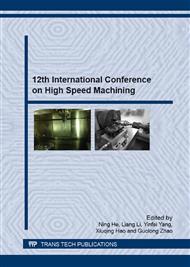[1]
Li Gang, Wang Yangyu, Zhou Haodong, FEM simulation on milling feature of transition region assembled hardened steels, J. Tool Engineering. 48(2014)24-27.
Google Scholar
[2]
Linhu Tang, Chengxiu Gao, Jianlong Huang, Experimental investigation of surface integrity in finish dry hard turning of hardened tool steel at different hardness levels, J. Adv Manuf Technol. 77(2015)1655–1669.
DOI: 10.1007/s00170-014-6484-1
Google Scholar
[3]
Linhu Tang, Chengxiu Gao, Jianlong Huang, Experimental investigation of the three-component forces in finish dry hard turning of hardened tool steel at different hardness levels, J. Adv Manuf Technol. 70(2014)1721–1729.
DOI: 10.1007/s00170-013-5423-x
Google Scholar
[4]
Yangyu Wang, Shiming Ji, Huiqiang Wang, Donghui Wen, Investigation on vibration of ball end milling hardness steel assembled with different hardness, J. China Mechanical Engineering. 23(2012) 636-641.
Google Scholar
[5]
Changing Du, Jianbo Cheng, Simulation of hard-state finish cutting process based on Advant Edge, J. Tool Engineering. 49(2015)27-31.
Google Scholar
[6]
Li Gang, Kong Zhifan, Wang Huiqiang, Finite element analysis of milling force on hardened steels assembled with different hardness, J. Machine Design and Research. 30(2014)130-135.
Google Scholar
[7]
Wen Donghui, Wang Yangyu, Ji Shiming, Numerical simulation on ball end milling harden steel assembled with different hardness, J. Journal of Harbin University of Science and Technology. 16(2011)16-20.
Google Scholar
[8]
Satish Chinchanikar, Predictive modeling for flank wear progression of coated carbide tool in turning hardened steel under practical machining conditions, J. The International Journal of Advanced Manufacturing Technology February. 76(2015).
DOI: 10.1007/s00170-014-6285-6
Google Scholar
[9]
Yan Shuai, Wang Jianming, Hu Xiaokang, Lu Yi, The Vericut research of titanium alloy based on DEFORM-3D, J. Combination Machine Tools and Automatic Processing Technology. 10(2014)135-141.
Google Scholar
[10]
Jianlong Huang, Yue Yun, The dry hard turning simulation of 30CrNiMo8 based on DEFORM-3D, J. Machinery Manufacturing 49(2011)56-60.
Google Scholar
[11]
Cheng Fujun, Cheng Dingguo, The simulation analysis for the milling process of ball end mill using the DEFORM-3D, J. Mechanical Science and Technology. 49(2011)56-60.
Google Scholar
[12]
Hu Jingjun, Li Xiaoping, DEFORM-3D plastic dieing CAE application tutorial, J. Peking University Press. (2011).
Google Scholar
[13]
Gang Li , FEM simulation on milling feature of transition region assembled hardened steels, J. Tool Engineering. 48(2014).
Google Scholar
[14]
Wei Kunxia, Sun Yaun, Wei Wei, An investigation on bulk dengsity and shore hardness of metal/carbon graphite composites. J. Materials Review 28(2014)81-85.
Google Scholar


